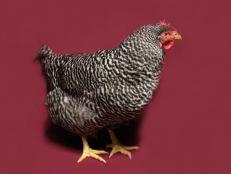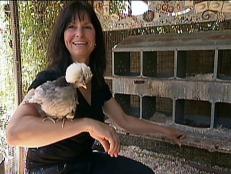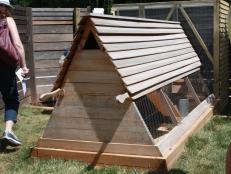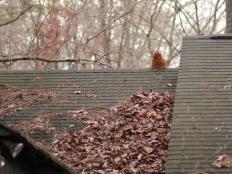45 Heritage Chicken Breeds
Appenzeller Chickens
The Appenzeller originated more than 400 years ago in the Appenzell region of Switzerland. The breed came close to extinction during World War II, but the dedication of German breeders in the 1950s ensured its survival. A good, hardy but flighty breed, Appenzellers do not do well in confinement and can fend for themselves if they have a good foraging area. Appenzellers are excellent tree climbers and fliers that will happily roost in trees. The breed is common in Europe, but fairly rare in the U.S.
©2012, Know Your Chickens, Fox Chapel Publishing
Pekin Chicken
The Pekin is a true bantam breed and one of the birds featured in Jack Byard's Know Your Chickens. They are small, gentle birds that require little space. One version of its history says they were liberated from the Chinese Emperor Xianfeng around 1860. Another story is that a number of Pekins were given to England’s Queen Victoria in the mid 1800s. Crosses with other breeds have resulted in today’s Pekins. Pekins are broody and only produce about 90 creamy-white colored small eggs a year.
©2012, Know Your Chickens, Fox Chapel Publishing
Faverolles Chicken
The Faverolles are native to Faverolles in Northern France. They were developed by crossing the Houdan, the Cochin and the Dorking. Their ancestry can be traced by their five toes. There are three different types of Faverolles, the original French, the German and the British. They were first imported into the USA in 1901-02 and were met with much enthusiasm, although only the salmon (shown) and white varieties are popular. This genteel bird is ideal for children and has been described as the peacock or French poodle of the chicken world. Faverolles are now found on most continents.
©2012, Know Your Chickens, Fox Chapel Publishing
Andalusian Chicken
Andalusians are native to Spain’s Andalusia region. The breed was further developed in the USA and the British Isles. In 1846, black and white Andalusia-imported birds were crossed, resulting in today’s rare Blue Andalusian, the first original blue fowl. Andalusians can be black, white, splash (mottled) or blue, the only color recognized by the American Poultry Association. This breed is small and active and the Andalusians are extremely fast runners. They tend to be noisy, rarely go broody, and lay about 160 creamy white eggs a year.
©2012, Know Your Chickens, Fox Chapel Publishing
Australorp Chicken
The Australorp, native to Australia, was developed as a dual-purpose egg and meat breed. Breeders crossed the Black Orpington with the Langshan, Minorca and White Leghorn. Its name originated from The Austral Orpington Club, which was founded for them. In 1922-23, a group of six Australorp hens laid 1,857 eggs (about 309 eggs each) over 365 consecutive days setting a world egg-laying record. The Black Australorp, shown, was introduced to North America in the 1920s and still lays about 250 light brown eggs a year. Australorps are docile, quiet, and friendly; a good choice for beginners.
©2012, Know Your Chickens, Fox Chapel Publishing
Ancona Chicken
The Ancona is among the oldest breeds of chicken. Native to Ancona, Italy, they arrived in the U.S. in the late-nineteenth century. These tough, hardy birds adapt easily to a range of environments and are great scavengers with an instinct for finding food. Anconas can lay 300 white eggs a year but are no longer commercially used. Anconas must be kept free range, but will fly away if not surrounded by a high fence.
©2012, Know Your Chickens, Fox Chapel Publishing
Barnvelder Chicken
Native to Barneveld, in the Netherlands, this breed was developed for its dark brown eggs in the 19th century by crossing a Dutch hen with a Langshan. Further crosses with the Buff Orpington, the Brahma and the Cochin improved the quality and color of the Barnvelder’s eggs. This hardy, heavy, dual purpose meat-and-eggs hen lays about 200 dark brown eggs each year. The Barnevelder is a lazy chicken and must be kept free range to ensure it receives plenty of exercise as overweight Barnvelders do not lay eggs. Found worldwide today, the quiet Barnevelder is both a utility and a show breed.
©2012, Know Your Chickens, Fox Chapel Publishing
Black Rock Chicken
The U.S.-native Black Rock is a hybrid, the result of a Rhode Island Red male and a Plymouth Rock female. The sex of this breed can be determined at a day old and as a result, male Black Rocks are rarely seen. This attractive, hardy breed has a highly developed immune system. This busy, inquisitive bird will roost in a tree if given a chance. Black Rocks are easy to handle and make ideal pets for older children. They lay up to 300 medium to dark brown eggs a year. The Black Rock enjoys freedom and becomes bored if confined. Today, Black Rocks can be found on most continents.
©2012, Know Your Chickens, Fox Chapel Publishing
Old English Game Chicken
The Old English Game has been strutting around the British Isles for more than 200 years and is a descendant of the ancient Pit Game fighting cock. Also a fighting bird, Old English Game hasn’t changed in appearance in the 2,000 years it’s been around. Now bred as a purely ornamental show bird, they still have an aggressive nature so, unless you are an extremely experienced breeder, this is not the breed for you. Despite being noisy and refusing to be confined, they are still one of the most popular game birds. Old English Games are now found in North America, Europe and Australia.
©2012, Know Your Chickens, Fox Chapel Publishing
Marsh Daisy Chicken
The Marsh Daisy chicken originated in Lancashire, England in the late 1800s. A good range of other poultry breeds went into the melting pot to produce the Marsh Daisy: The Black Hamburgh, the White Leghorn, the Malay and the Old English Game. The Pit Game and the Sicilian Buttercup were later added. The Marsh Daisy is considered an extremely rare breed and there are just a few worldwide.
©2012, Know Your Chickens, Fox Chapel Publishing
Java Chicken
The Java is native to the USA and is America’s second oldest breed of chicken. They are a dual-purpose meat-and-eggs breed ideal for small backyard flocks. Javas are believed to have Asian ancestry, hence its namesake Java, the Indonesian island. Javas were once commonplace in American farmyards from the 1850s through the 1880s. It has contributed to many other American breeds including the Jersey Giant, Rhode Island Red and the Plymouth Rock. Known for their hardiness, tastiness and brown egg laying ability, Javas are nearing extinction today.
©2012, Know Your Chickens, Fox Chapel Publishing
Lakenvelder Chicken
Despite its Dutch name, the Lakenvelder was developed on the Holland/Germany border in Westfalen, Germany in the 1830s. A fairly small bird, males weigh only about 5.5 pounds. Lakenvelders can live contentedly in a confined area but are much happier free range where they can forage. The non-broody Lakenvelder lays an average of 160 white or creamy white eggs per year. One breeder describes them as being “independently minded little souls, who prefer to forage rather than eat the grain supplied and will roost in trees.” Lakenvelders are found on most continents, but are rare in the U.S.
©Know Your Chickens, Fox Chapel Publishing
Leghorn Chicken
The Leghorn breed is one of the best known and produces the majority of the world’s supply of white eggs. A good white Leghorn will lay about 300 eggs a year; the Black and Brown lay slightly less at about 200 to 250 a year. A strutting, noisy bird with presence, the Leghorn is a good forager capable of flying a good distance and will happily roost in a tree.
©2012, Know Your Chickens, Fox Chapel Publishing
Belgian d'Uccle Chicken
The Belgian d'Uccle (pronounced dew-kluh) is a small bird known for being calm, docile and friendly. They were developed in the town of Uccle, near Brussels Belgium around the 1890s. It is believed that the breed was produced by crossing the Dutch Sabelpoot bantam and the Antwerp Bearded bantam. The Mille Fleur, shown, is one of the first varieties of d’Uccle. A broody breed, the Belgian d’Uccle‘s eggs are notably small and cream colored. Belgian d’Uccles are now found in the U.S., Europe and Australia.
©2012, Know Your Chickens, Fox Chapel Publishing
Lincolnshire Buff Chicken
The Lincolnshire Buff was developed in Lincolnshire, England, more than 150 years ago by crossing the Cochin and the Brahma with local breeds. The Lincolnshire Buff was once a farming mainstay until the Buff Orpington came along. By 1920, the breed had almost disappeared but was painstakingly brought back into being in 1987. Now found in the British Isles, the rare Lincolnshire Buff has been accepted as a standard breed by the Poultry Club of Great Britain.
©2012, Know Your Chickens, Fox Chapel Publishing
Croad Langshan Chicken
Croad Langshans are large, intelligent, strong yet graceful birds. It is an ancient breed from the Langshan district of Northern China. Imported to North America in 1878, Croad Langshans were a popular dual-purpose meat and eggs breed. The Langshan was used to create the Maran, Barnevelder and the Black Orpington breeds. They are heavy birds that do not fly much. Croad Langshan hens can lay up to 200 light brown-lilac colored eggs annually, and are large enough to sit over a dozen eggs at a time. Croad Langshans are friendly, docile and quiet; an excellent choice for families.
©2012, Know Your Chickens, Fox Chapel Publishing
Plymouth Rock Chicken
This Plymouth Rock was developed in New England during the mid 1800s. Many breeders claim to have developed the Plymouth Rock, but the honor has been given to John C. Bennett, who was involved in the development and popularizing of the breed. Crosses between the Dominique, Cochin and Black Java, with a touch of Malay and Dorking produced the Plymouth Rock. Before World War II, it was the most popular breed in America. The Barred variety (shown) was first on the market. Plymouth Rocks are now found in North America, Europe and Australia.
©2012, Know Your Chickens, Fox Chapel Publishing
Poland Chicken
The Poland is possibly the most popular of the crested breeds. It is also one of the oldest and has been known as a pure breed throughout Europe since the 1500s. The Poland is thought to have originated in Poland and Eastern Europe. There are unsubstantiated claims that it began in the Netherlands. Originally used for its production of white eggs, the Poland’s main use is now ornamental. They are not suited to cold weather because they have unusually thin skulls making them susceptible to hypothermia. The Poland breed is now found on most continents.
©2012, Know Your Chickens, Fox Chapel Publishing
Red Jungle Fowl
The Red Jungle Fowl is not a chicken, but a breed of tropical pheasant. It was Charles Darwin who determined that the Red Jungle Fowl along with the Grey Jungle Fowl, was the wild ancestor of the modern chicken. Archaeological evidence has suggested that the Red Jungle Fowl was used for food and eggs in India 5,200 years ago.
©2012, Know Your Chickens, Fox Chapel Publishing
Scots Dumpy Chicken
Scots Dumpys, also called Bakies, Crawlers, Creepers or Corlaighs, are a breed of chicken native to Scotland. Their decline began with the Highland Clearances of the 18th and 19th centuries. A small flock was taken to Kenya in 1902, but a number of these were returned to their homeland as breeding stock. By the 1960s, the Scots Dumpy was more or less extinct and is still rare today. The short-legged bird is cold hardy and a dual-purpose meat and eggs breed, laying up to 200 eggs a year. Scots Dumpys are now found in small numbers throughout the U.K. and Kenya.
©2012, Know Your Chickens, Fox Chapel Publishing
Silkie Chicken
The Silkie is one of the oldest breeds of chicken and is known for its fluffy fur-like feathers. Its place of origin is most likely China, but Japan and India are also mentioned. Arriving in Europe more than 200 years ago, early poultry dealers sold them to the public as a cross between a rabbit and a chicken! Silkies lay about 100 cream-colored eggs year, but not at all during the summer months. Its grey-black meat is generally not palatable. Silkies require little space and are ideal for children or a small yard. They are now found worldwide.
©2012, Know Your Chickens, Fox Chapel Publishing
Wyandotte Chicken
The Wyandotte originated in New York State and Wisconsin in the 1800s. Named after the Wyandot American Indian tribe, its history is vague. It is a cross between the Cochin, the Silver Spangled Hamburgh and something else, however further developments and refinements continued until 1883. The Wyandotte is often called the “bird of curves” because of its shape. It is calm, docile and adaptable to free-range life or smaller garden runs. It is a dual-purpose breed, suitable for farm or show, and lays up to 200 light to dark brown eggs a year. Wyandottes are now found on most continents.
©2012, Know Your Chickens, Fox Chapel Publishing
Welsummer Chicken
The Welsummer is known for its deep reddish brown, sometimes speckled, eggs. Developed in Welsum, Holland during the early 20th century, it is a cross between the Cochin, Wyandotte and Leghorn. The Rhode Island Red and Barnevelder were later added to help stabilize the breed. Welsummers are found in the British Isles, Australia and North America, but are reasonably rare in the U.S., except in Oklahoma. Welsummers are good foragers and will save you on feed if they range freely! Here’s another tidbit: The chicken on the famous cornflakes box is a Welsummer rooster!
©2012, Know Your Chickens, Fox Chapel Publishing
Scots Grey Chicken
The Scots Grey is a very old and rare breed whose history goes back to the 1500s when they would have been a common sight on farms in Lanarkshire, Scotland. This long-legged, erect-standing bird is an endangered breed. It is possible there are only 200 Scots Grey hens in the British Isles. The Scots Grey is known for its hardiness and its ability to survive harsh conditions. It has a great ability to forage and requires plenty of space to roam. Now found in the British Isles and Kenya, many are kept for purely ornamental reasons.
©2012, Know Your Chickens, Fox Chapel Publishing
Rhode Island Red Chicken
Rhode Island Reds are possibly one of the most recognized breeds of chicken. This breed originated in the early 1900s in Little Compton in Rhode Island, where it is the state bird. The breed was developed by crossing the Asiatic Black-Red and a black-breasted Malay cock. A Rhode Island Red cock is on display at the Smithsonian Institution. Hardy and disease resistant, Rhode Island Reds are ideal if you want a small flock. This dual-purpose meat and eggs breed is used more for eggs since a good hen can lay between 250 and 300 brown eggs per year, although 170 to 200 is a good average.
©2012, Know Your Chickens, Fox Chapel Publishing
Sussex Chicken
The Sussex is a very old breed developed in Sussex, England. The speckled Sussex (shown) is believed to be the oldest. There is a school of thought that suggests the Old English Game bird was the starting point for the Sussex. This dual-purpose eggs and meat breed was one of the main sources of meat and eggs for London. Its hens lay about 260 eggs a year and most are not likely to go broody, but if they do, it’s usually the speckled Sussex. The adaptable, docile Sussex is comfortable in free range or confined spaces and around humans. They are now found in the British Isles.
©2012, Know Your Chickens, Fox Chapel Publishing
Vorwerk Chickens
Oskar Vorwerk developed the Vorwerk breed in Germany in 1900. The intention was to produce a medium-sized dual-purpose meat and eggs breed that was gentle, hardy, a good forager and ideal for a small farm. In 1966, William Vorwerk (no relation to Oskar) tried to buy Vorwerks in America, but was unable to find any so he bred his own. This was the beginning of the bantam Vorwerk which is identical to the German breed, only smaller. Vorwerks are often called Golden Lakenvelders in North America.
©2012, Know Your Chickens, Fox Chapel Publishing
Sebright Chicken
The Sebright is one of the oldest bantam breeds. Named after its developer Englishman Sir John Saunders Sebright in the 1800s, it is a true bantam. The Sebright’s exact make-up is uncertain but it is believed that the Rosecomb bantam was the basis. British and Polish birds with a touch of Hamburgh and Nankin were also crossed. Sir John eventually developed a laced bantam that would regularly breed true and the refinement continued through until 1952 before finally achieving the Sebrights of today. Sebrights are hardy but purely ornamental. They can be found on most continents.
©2012, Know Your Chickens, Fox Chapel Publishing
Sumatra Chicken
The Sumatra, usually called the Black Sumatra, is rare but the Blue variety is even rarer. They come from Sumatra, Indonesia and were first intended as a cockfighting breed. Sumatras were introduced into America in 1847 and the breed has remained unchanged since then. The Sumatra lays about 120 white eggs a year but is not weighty enough to be a meat bird. It is considered a purely ornamental breed with its long, sweeping black tail and peacock elegance. Sumatras don’t tolerate confinement well and will happily roost in trees. They can be found scattered throughout most continents.
©2012, Know Your Chickens, Fox Chapel Publishing
Chicken Combs
Combs refer to the fleshy crown, or crest, on top of a chicken’s head. They are usually red, but can be light gray, black, dark purple or deep blue depending on the breed. Combs are generally larger on males than on females and may be a reliable indicator of the bird’s health and vigor.
©2012, Know Your Chickens, Fox Chapel Publishing
Dutch Bantam Chicken
Dutch Bantams are one of the smallest breeds of bantam. They are “true bantams” because they are naturally small and haven’t been miniaturized from other larger breeds. Dutch bantams are practical chickens, hardy and good layers for their size. They are desirable family pets due to their reputation for thriving on loving care and their ability to be kept in confined space. They are good flyers so a good aviary or a high fence is a necessity. Dutch Bantams are found worldwide.
©2012, Know Your Chickens, Fox Chapel Publishing
Orpington Chicken
The Orpington was developed in Kent, England in the 1800s by the son of a hostler who decided he'd rather work with chickens than horses. The breed is a cross between the Minorca, the Langshan and the Plymouth Rock. It is believed the Orpington first arrived in America in 1890. The first Orpingtons were black and very similar in appearance to the Langshan. The Buff Orpington, shown, was developed in 1894 in response to popular demand for buff-colored birds. The Orpington can adapt to small pens but they have a tendency to overeat. Free range is better as it keeps them fit.
©2012, Know Your Chickens, Fox Chapel Publishing
Maran Chicken
Marans are known and prized for their chocolate-colored brown eggs. Laying around 150 dark brown eggs a year, Marans are generally quiet and docile; however they are active and take well to free ranging. They are also tough, disease-resistant and tolerate wetter climates. Native to France, small numbers of Marans were imported to the U.S. Their increased popularity in America spawned the formation of the Marans Chicken Club USA in 2008.
©2012, Know Your Chickens, Fox Chapel Publishing
Indian Game Chicken
The Indian Game is an old British breed developed in Cornwall, England in the 1800s. Initially developed for cockfighting, the Red Asil, Malay and Old English Game were crossed. The resulting Indian Game was too heavy to be a good fighter. Little seen outside Cornwall until the end of the 1800s, The Indian Game’s true worth was realized in the quality of its meat, a trait valued to this day. Indian Game are poor layers, producing only about 80 light brown eggs per year. Today, Indian Game can be seen at poultry shows worldwide.
©2012, Know Your Chickens, Fox Chapel Publishing
Legbar Chicken
The Legbar was developed in a Cambridge University breeding program by crossing the Brown Leghorn, Barred Rock and Araucana chickens. The Legbar is known as an autosex breed, meaning the sex can easily be distinguished at birth. They lay about 180 sky-blue or olive-green colored eggs a year. Legbars are vigorous, sprightly, alert and happy in small or large runs; if kept in a large run, trying to catch one will prove difficult. Legbars are found in the British Isles, Australia and New Zealand, but are scarce in the U.S.
©2012, Know Your Chickens, Fox Chapel Publishing
Hamburgh Chicken
With a history dating back to the 1600s, The Hamburgh’s country of origin is actually unclear despite its name. The spangled Hamburgh, shown, was developed in England in the 1700s. This small breed lays about 150 eggs per year. It was once known as the Dutch Everyday Layer but is mainly ornamental now. Hamburghs also go by the name of “Moonies” because of their spangles. Stylish, elegant and snappy describe this bird. Hamburghs thrive best when free range. They are good foragers and capable of flying a good distance. Hamburghs are now found in the U.S., Europe and Australia.
©2012, Know Your Chickens, Fox Chapel Publishing
Araucana Chicken
The Araucana is an ancient breed named after the Araucan Indians who lived on the Andes Mountains plains in Chile. The Araucana does not lay many eggs, but the eggshell colors, inside and out, are spectacular. They are mainly blue or green but can range from greenish blue to violet blue to greyish. Araucanas are hardy, grow quickly and mature fast. They are content to be in a pen as long as there is a regular supply of fresh grass. Araucanas are found worldwide, however the Lavender Araucana, shown, is rare in the U.S.
©2012, Know Your Chickens, Fox Chapel Publishing
Brahma Chicken
The Brahma is named after the Brahmaputra River in India. For many years its true origin has been in doubt, but most breeders now agree that the Brahma, formerly called the Indian Grey Chittagong, was developed in America and that the Shanghai, now known as the Cochin, was used to improve the breed. In the mid-1800s, nine birds were sent to England as a gift for Queen Victoria. Today, Brahmas are mainly bred for ornamental use. The feathered legs and feet must be kept clean and dry as caked mud causes serious damage to the feet and legs. Brahmas are now found on most continents.
©2012, Know Your Chickens, Fox Chapel Publishing
Cochin Chicken
The Cochin, originally called the Shanghai, originated in China and was imported into the USA and the British Isles in the 1800s. The appearance of these large, fluffy birds was like no other breed at that time. The Cochin became an overnight success and a must-have. In 1853, in the U.K. one sold for £2,587 ($4,000). It was known as the Cochin Craze. After being imported to the USA, Cochins were further developed into the breed we have today. Cochins are cold hardy but their thick feathers can cause over-heating in the summer. A gentle spray with water will keep them cool.
©2012, Know Your Chickens, Fox Chapel Publishing
Dominique Chicken
The Dominique is the oldest chicken breed in America and most likely the first breed to be developed here. By the mid-1700s, this was the most popular breed in America. Dominiques are weather hardy and are happiest running free. In the mid- to late 1800s, the Dominique was used to develop the Plymouth Rock, which immediately took over the Dominique’s popularity. The number of Dominiques decreased and by 1950, they were rare. Twenty years later, the numbers were classed as critical. Recently there has been revived interest in the Dominique and its numbers are increasing.
©2012, Know Your Chickens, Fox Chapel Publishing
Dorking Chicken
Bred in Italy during Julius Caesar’s reign (100 to 44 BC), the Dorking is one of the oldest domesticated poultry breeds. They have five toes, not four, an indication of ancient origins. The Romans brought this dual-purpose meat-and-eggs breed to the British Isles, where most of the development and improvement took place. The Dorking traveled to America with the early settlers. The Dorking has been used to develop many modern breeds. It is a large, docile bird that needs a large area to exercise and forage. Dorkings are now rare with less than 500 breeding pairs remaining.
©2012, Know Your Chickens, Fox Chapel Publishing
Golden Phoenix Chicken
The Golden Phoenix originated in Japan where it was known as the Onagadori. It was one of several long-tailed breeds that have been bred in Japan for a thousand years and kept in the Imperial Gardens. The tail feathers could reach 33 feet in length. In the 1800s, the Golden Phoenix was crossed with German game birds in order to improve its health and well being. Further development and improvement was carried out in America using the Leghorn, but the long tail feathers were lost. Today, only the males have long tail feathers (up to 3 feet long.) Golden Phoenixes are now found worldwide.
©2012, Know Your Chickens, Fox Chapel Publishing
Jersey Giant Chicken
The breed was developed in the late-1800s by two brothers, John and Thomas Black, of Burlington County in New Jersey. The breed was developed by crossing the Dark Brahma, the Black Java, the Black Langshan and possibly the Black Orpington. This is a large bird, originally bred as a table bird that could be an alternative to turkey. A mature Jersey Giant weighs an average of 13 pounds. It is a dual-purpose meat and eggs breed. The Jersey Giant is the world’s largest chicken breed, but they are too slow growing for commercial breeders. Jersey Giant are found on most continents.
©2012, Know Your Chickens, Fox Chapel Publishing
Japanese Bantam
The development of the Japanese Bantam or Chabo (the Japanese word for dwarf) dates back to at least the 1600s. It is a cross of breeds from China and South East Asia and was once seen around the gardens of rich and famous Japanese. The breed arrived in the USA and Europe by the 1800s, and was a feature in both Japanese and Dutch art of that period. The Japanese Bantam, a true bantam, has very short legs and when walking appears duck-like. This small bird has a large tail that reaches above its head. With good care the Japanese Bantam will live over ten years.
©2012, Know Your Chickens, Fox Chapel Publishing
American Game Fowl
These highly intelligent birds were once bred for cockfighting. Thanks to recent law changes, in America and Europe they are now bred for their beauty and as a show breed. American Game birds are good foragers, excellent mothers and are normally easy to handle. They lay about 70 white to cream-colored eggs a year. Put two mature roosters together and they will do what is in their nature: fight to the end.
©2012, Know Your Chickens, Fox Chapel Publishing











